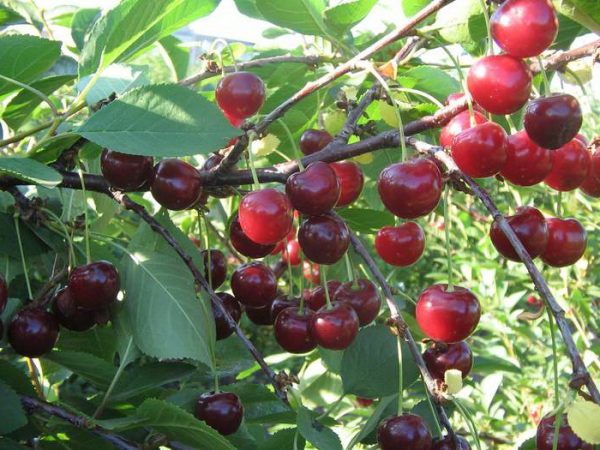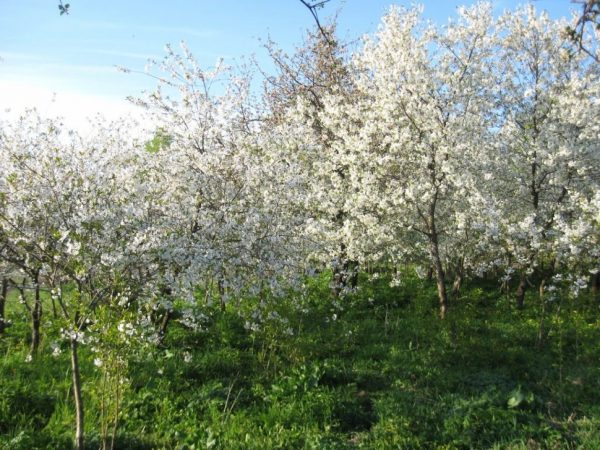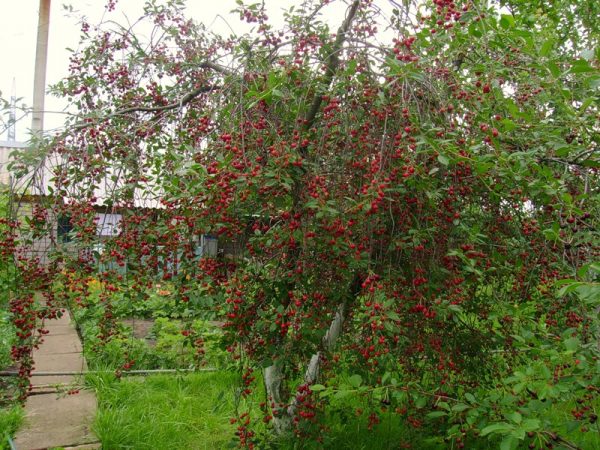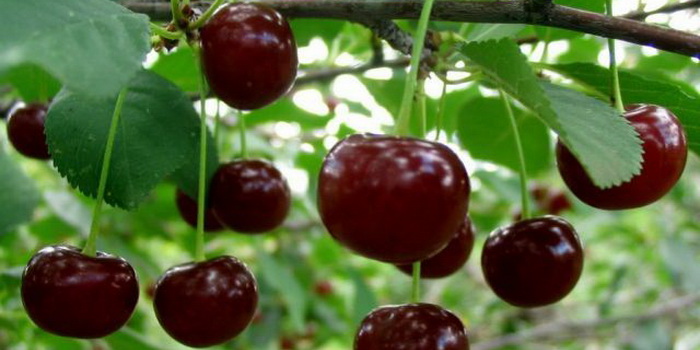One of the most common varieties of cherries in Russia is considered to be generous. This variety is ideal for the northwestern and northeastern regions.
Variety Generous appeared in consequence of the crossing of ordinary and power cherry, he received in 1959. The height of the bush reaches about 2 m. The plant has a rounded shape, different spreading branches. With proper care, cherry is able to bear fruit for 35 years.
Table of contents
Description and characteristics of the fruit of the cherry
Let's start with the description of the cherry. Berries varieties of generous small size. The maximum mass of a single cherry is 5 g, but they have a rather attractive appearance. Fruits are characterized by a rich dark red color and regular rounded shape.
It is also clear distinctive features that they almost do not crumble and in the case of over-aging they do not appear cracks. The fruit of the cherry Generous juicy, brilliantly, with a pleasant sour-sweet taste and rich cherry aroma. Stone is quite large and easily separated from the pulp.
Cherries have a high density. During the tasting, the taste of the berries of the generous variety received a rating of 4.5 points, which is considered to be a fairly good indicator.
The advantages and disadvantages of the variety
Cherry of this variety has certain advantages, which significantly distinguish it from other varieties.
- High yield - Without dressings and tedious care it is possible to get a good harvest.
- Resistance to weather - a plant without complications withstands severe cold up to 35-47 ° C with a minus sign. Even if frosts occur during flowering, yields remain satisfactory, because the buds of the tree are resistant to low temperatures.
- Drought tolerance - Cherry feels well and develops properly even with a small amount of precipitation.
The disadvantages of the variety are:
- uneven ripening of berries;
- At times, Generous may be affected by various diseases.

Planting and care
The best time to plant a generous cherry is spring. This variety is unpretentious to the composition of the soil, but it is recommended to use places on hills that are not flooded, dry, with light sandy soil.
In addition, sunlight should fall on the selected location. For cherries, you need to select areas that are sufficiently protected from the north winds.
Deepening landing also prepared in the autumn. Dig them to a depth of 50 cm and a diameter of approximately 90 cm.
The prepared soil is placed in this recess: the top layer of the earth is mixed with compost and 30 grams of superphosphate, 20 grams of potassium chloride and 1 kg of wood ash are applied.
A seedling is placed on a hill made in a hole and well buried.
At the end of planting, 3-4 buckets of water are poured into the constructed well and peat or compost is introduced.
When the cherry is planted, then for the first 2 years care for it consists only in watering, loosening the soil and destroying the weeds. In the autumn period, the soil around the seedling is carefully, not touching the roots, dug to a depth of about 10 cm.
When the plant begins to bear fruit, the amount of fertilizer increases. The first part of the nitrogen fertilizer is recommended to be applied in the springtime, and the second - at the end of the flowering period.
The seedling is watered more often as soon as the soil dries. About 3-4 buckets of water per 1 square meter are poured on one irrigation procedure. m
You may also be interested in the following articles about cherry:
Cherry, which bears fruit, receives less water: watering is carried out only 3 times a year.
- First, the plant is watered immediately after the flowering period;
- Next time - during the ripening of the fruit.
- The third time - before the winter cold, in October.
With a severe drought, bush cherry needs more water. For one irrigation procedure, at least 5–6 buckets of water per 1 square meter are required. m
In addition to fertilizers, irrigation and loosening, the Generous variety must be pruned every year.
An adult cherry should have 10–15 main branches. After 4–5 years, the crown of the plant must be completely formed. Subsequent pruning is carried out only to maintain the same species.
When the buds begin to swell, it is possible to see which branches need to be eliminated, and which ones should not. Dried, old and diseased twigs cut and grease the sections of cuts with thick garden pitch.
Also cut off and excess root shoots, which significantly weakens the cherries. When pruning can not be allowed excessive thickening, and in time to get rid of the branches that grow inside the plant.This procedure will not only increase the amount of the crop, but will also significantly reduce the likelihood of disease.

Harvesting and Storage
The first berries are harvested around the third year after planting. Yields are noted as high and regular. During the summer, 10–18 kg of fruits are harvested in a single cherry, and after a few years, these figures do not decrease. Generous recognized late variety. The cherry blossom begins in late spring, and the berries ripen in late August - early September.
Taking into account the fact that cherries unevenly ripen, it is necessary to harvest in several stages. Although generous and samoplodny variety, to increase its productivity, gardeners with experience advise to plant it next to trees of pollinating varieties, for example, Subbotinskaya, Polevka or Maksimovskaya.
Since the fruits have a high density, they can easily transfer transportation. The period of storing them in torn form is a maximum of 1 week.
Features Cherry Generous
The main features of this class are:
- the variety may be grown in the northern regions of Russia;
- ripened cherries are not showered;
- the variety is self-fertile;
- durability - with proper care, the plant can live up to 35 years, while maintaining good yields.

Diseases and pests
Cherry Generous, though not constantly, but prone to diseases: moniliasis and coccomycosis. This variety is quite resistant to pests, but at times it suffers from a slimy sawfly or a cherry aphid. It happens during prolonged rains.
Moniliasis is a fungal disease of the nature that affects the cherry completely.The causative agent of moniliosis spends the winter in the bark of the branches and shoots, and it appears during the flowering period. The first to get sick are the bark, shoots and leaves.
On their surface is formed of thick gray moss, growing inside the cherry. Because of this, the moss of the bark of the plant is cracked and the branches and leaves are completely dry. Diseased berries soon begin to rot, dry out and can be stored on the plant in a similar form throughout the winter period. Fungal spores in them remain until the onset of spring.
To get rid of the disease, you should regularly remove diseased leaves, shoots, berries, and be sure to burn them.Before and after flowering, it is recommended to treat the bush with an aqueous solution of copper oxychloride.
After harvesting a good result gives a spraying of a one-percent solution of Bordeaux mixture. For the prevention of this solution, you can treat the plant in early spring, before the appearance of the leaves.
Coccomycosis is also a fungal disease, but it affects mainly the leaves and berries. It is possible to notice it at the initial stage, when small red spots appear on the top of the leaves.
These specks quickly grow and cover the entire surface of the leaves, and then spread to the fruit. All diseased leaves fall off in July, and the berries dry up. If the disease is not treated, then in a year the plant will die.
Winter cold kokkomikoza fungus holds in fallen leaves. In this regard, it is very important in time to pick off and burn dry leaves. To combat this disease, the treatment of the bush and the soil beneath it with a 1% Bordeaux liquid twice or once is perfectly suited, and at the end of flowering with a solution of copper oxychloride.
The slimy cherry sawfly rarely appears on cherries, but it causes significant harm.The larvae of such an insect feed on the leaves of the plant. They lay eggs at the bottom of the leaves, and after 10–14 days, the larvae appear from them.
It is possible to protect cherries from them by permanently loosening the soil around the bush and treating it with insecticides. Aphid lays eggs for the winter time on the shoots of the plant, next to the buds.
In the spring, the hatched larvae begin to feed on the juice of the newly formed leaves, and are able to destroy the cherries fairly quickly.
To get rid of aphids plant sprayed with special means. A remarkable effect gives a solution of wood ash: 300 grams per 3 liters of boiled water. In such a solution pour a little crushed tar soap, make a liquid volume of 10 liters and add 2 tbsp. l vinegar.
Cherry is treated with this solution before and after flowering.
Gardeners reviews
Dmitriy: I have several bushes of this variety in my dacha. I am very satisfied. It is easy to care for him, I can do it. Cherries are great for compotes that are aromatic and with great taste.
Helena: Engaged in the cultivation of varieties of generous since 2010. Currently, four shrubs of this variety have been planted in the garden and I plan to plant a couple more seedlings.Berries go for processing: I make juice and jams.
Maria: We have on the dacha growing cherries generous. Its fruits are tasty, but due to the fact that the berries ripen unevenly, they have to be collected in several approaches. And it takes a lot of time, which is already short.
Generous - this is quite undemanding variety of cherries, with a huge number of advantages. And despite some shortcomings, for 55 years, this cherry has received positive feedback from gardeners and claims to be the most popular variety in the gardens of our country.
